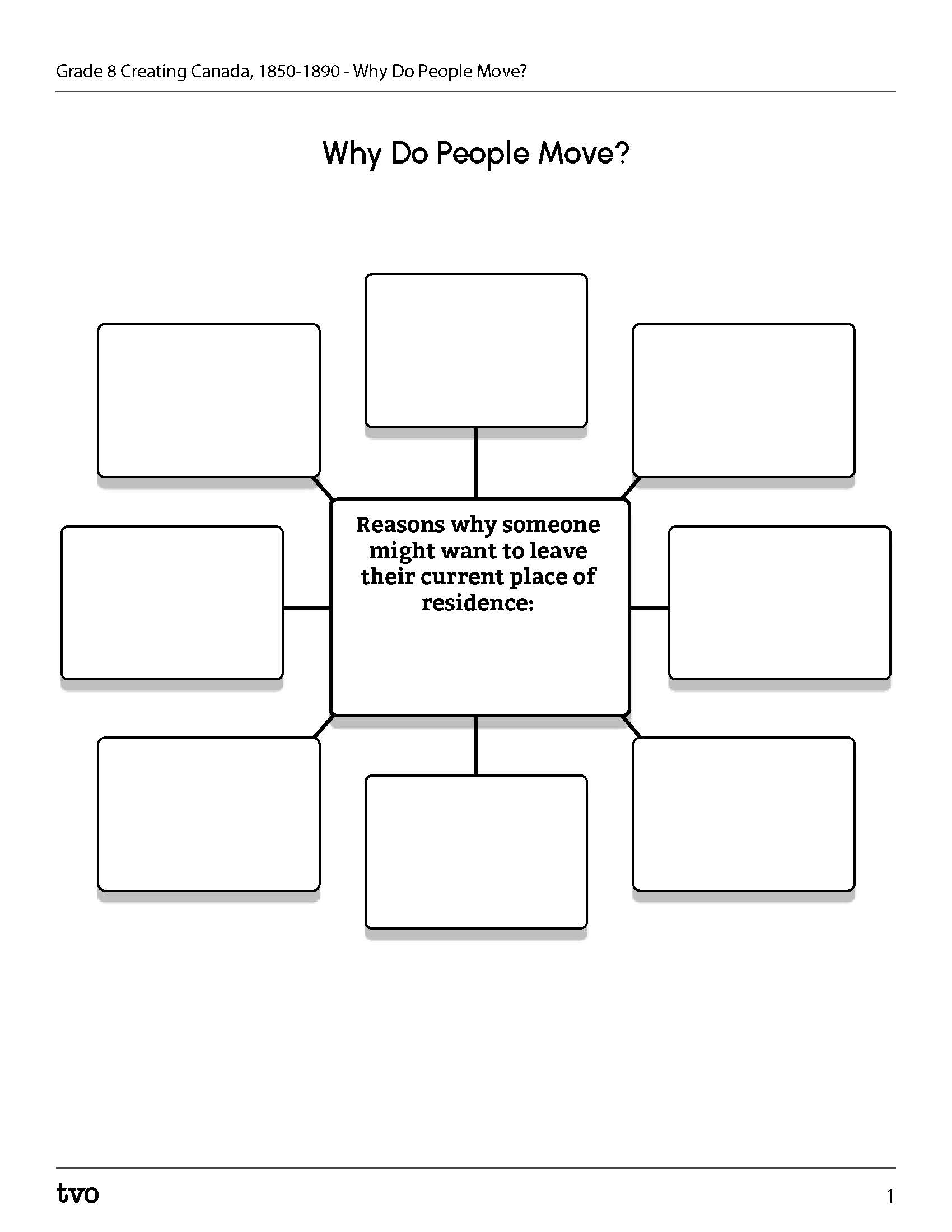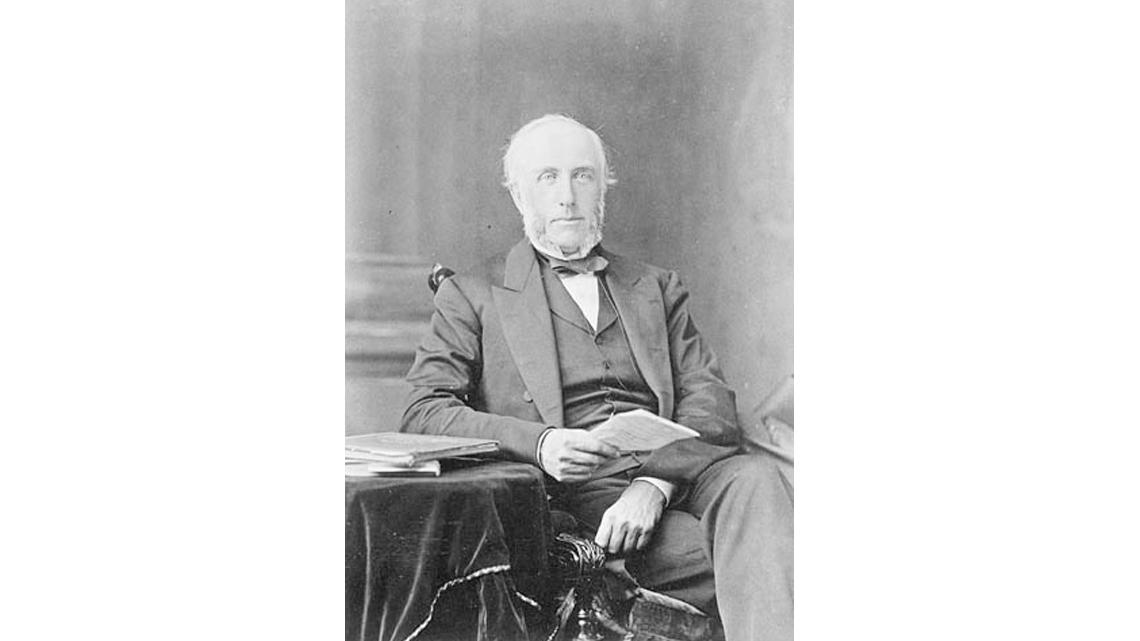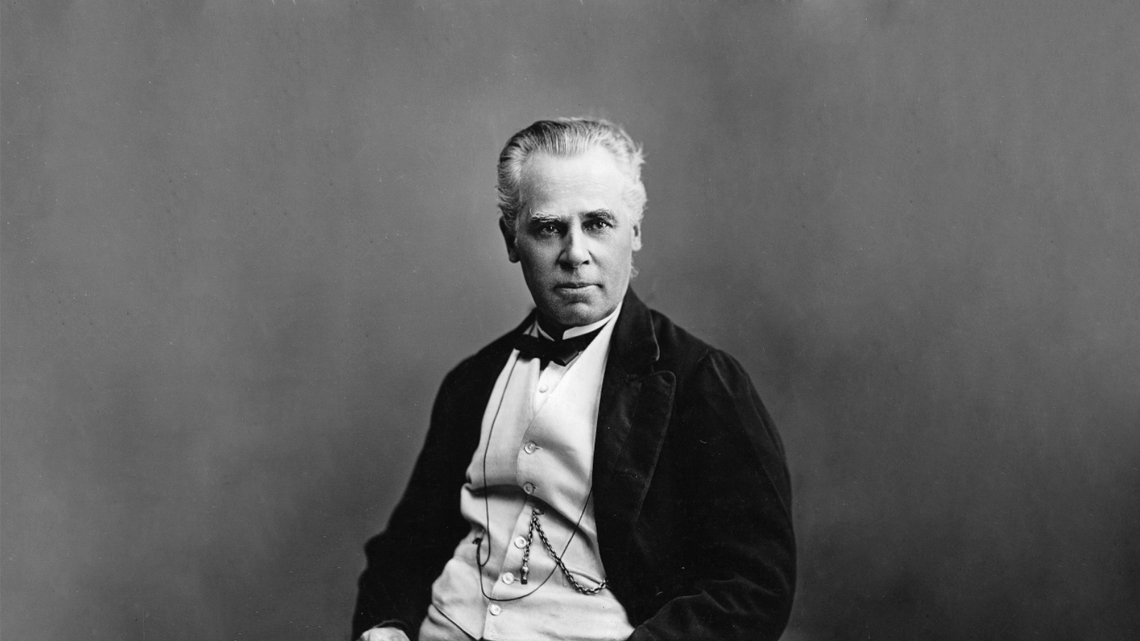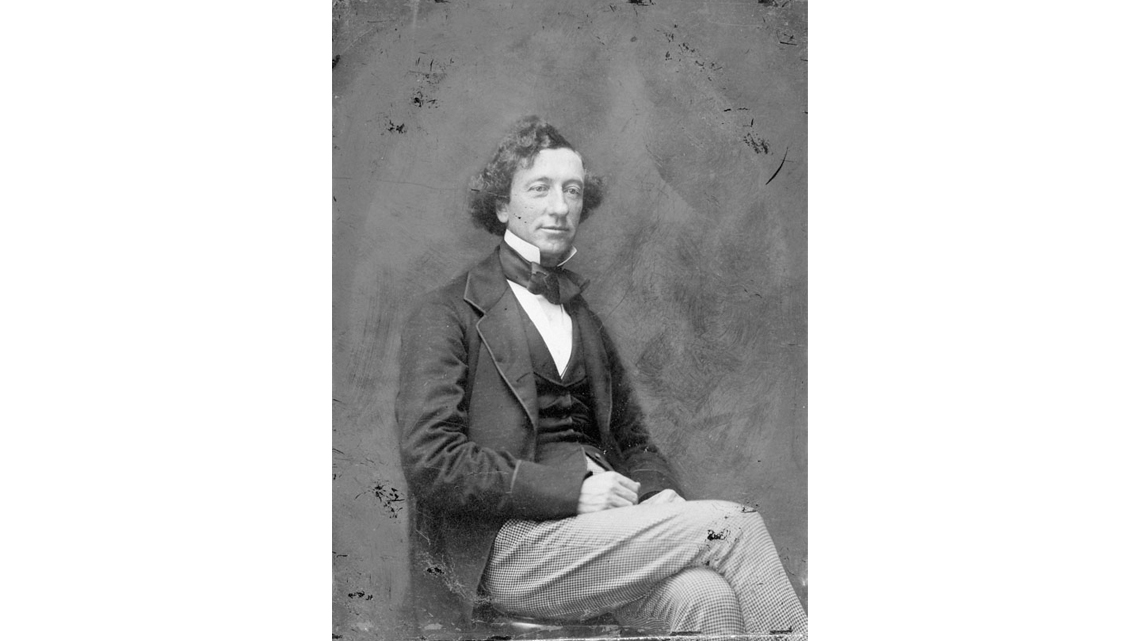Minds On
Why is where we live so important?
If someone was to leave their place of residence for a new place of residence, what reasons might they have for moving?
Brainstorm
Why do people move?

Brainstorm a list of reasons why someone might want to leave their current place of residence.
Complete Why Do People Move? in your notebook or use the following fillable and printable document. You can include both words and images to describe your thinking.
You should now have a list of reasons why someone might move. What rules or expectations do you think they might hope for in their new place of residence?
Press ‘Hint’ to reveal an example.
Brainstorm
What do people hope for when they move?

Brainstorm a list of rules and expectations someone may expect in their new residence. What reasons do you think they would have for wanting for these rules and expectations?
Complete What Do People Hope For? in your notebook or using the following fillable and printable document. You can include both words and images to describe your thinking.
| Reasons why someone might want to leave their current place of residence: |
|---|
Press the ‘Activity’ button to access What Do People Hope For?
Student Success
Think-Pair-Share
Do you think other people will have the same items on their lists as you?
If possible, compare both of your lists with a peer. What things do you have in common? What is different?
With or without a partner, reflect on and record your ideas on why two people may have different items on their lists.
Note to teachers: See your teacher guide for collaboration tools, ideas and suggestions.
Action
Canadian Confederation
In this task, you will be learning about Confederation and the reasons the provinces of Canada chose to form a union.
Explore the following passages. As you examine the section, consider the reasons for Canada to seek its first steps of independence from Britain.
Steps to Confederation

This is a map of the Dominion of Canada, as of July 1st, 1867. From left to right, the Dominion of Canada consists of provinces, Ontario, Quebec, New Brunswick, and Nova Scotia.
In 1867, the Dominion of Canada was created. Known as Confederation, at that time the Dominion of Canada consisted of four provinces: Ontario, Quebec, New Brunswick, and Nova Scotia.
Press ‘Confederation’ to reveal the description of the term.
Beginning in 1864, politicians in Canada (eventually known as the Fathers of Confederation) met in three separate conferences in Charlottetown, Quebec City and London, England to discuss and negotiate the terms of Confederation.
The British North America Act (BNA Act), Canada’s Constitution, was passed by British Parliament in 1867, and by 1999, six more provinces and three more territories would join.
Press ‘Constitution’ to reveal the description of the term.
Multiple choice question
Complete the following multiple choice question relating to Confederation.
Reasons for Confederation
During the early 1860s, politicians in Canada recognized six reasons for confederation.
Press the following six tabs to explore the six reasons for Confederation.
What was the most important reason for Confederation?
After exploring the six reasons above, which reason do you think is the most important reason for Confederation?
Rank the reasons in the following fillable and printable Reasons for Confederation Chart. Use the number 1 for the most important reason and the number 6 for the least. Be prepared to defend your answer in the Consolidation portion of this lesson. You may also complete this using a method of your choice.
| Reason | Ranking 1 – most important 6 – least important |
Reason for ranking |
|---|---|---|
| Political deadlock | ||
| Threat of American expansion | ||
| Railway | ||
| Self-sufficiency from Great Britain | ||
| Cancellation of the Reciprocity Treaty | ||
| Expansion into the West |
Complete the Reasons for Confederation Chart in your notebook, in the following fillable and printable document or in a method of your choice.
Press the ‘Activity’ button to access the Reasons for Confederation Chart.
Contributors to Confederation
Thirty-six men are usually regarded as the Fathers of Confederation in Canada.
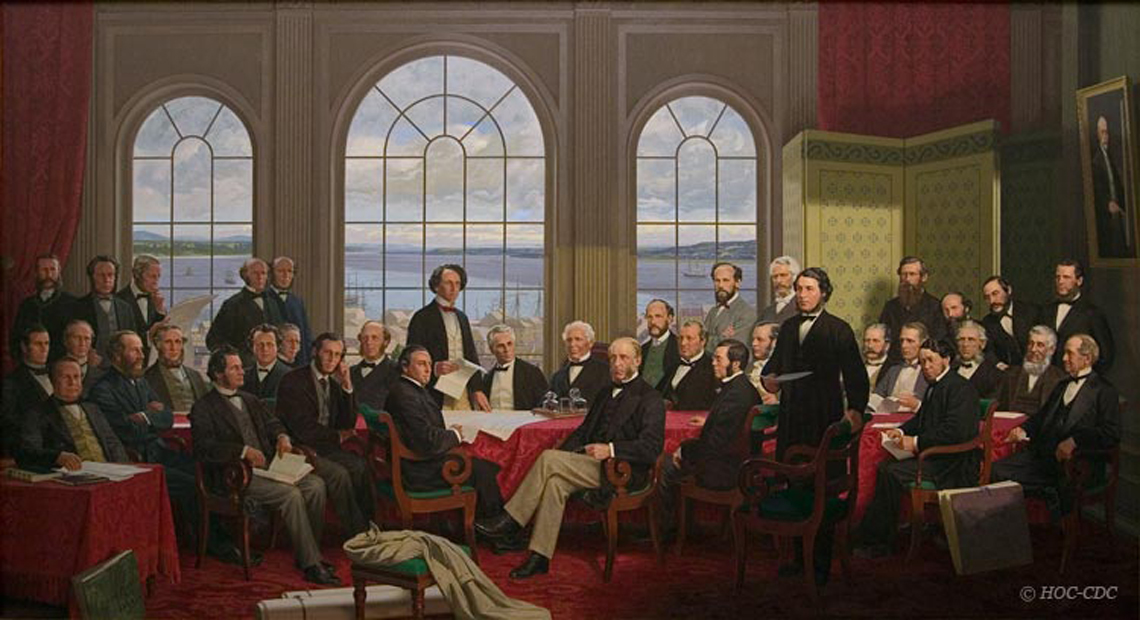
A painting by Robert Harris portrays the Fathers of Confederation. Originally commissioned to represent the representatives at the Charlottetown Conference of 1864, the painting was later expanded to feature all thirty-six Fathers of Confederation. The painting was installed in the original Parliament Buildings in 1884.
These men, depicted in the 1968 painting by Rex Woods, represented the British North American colonies at one or more of the three conferences that eventually led to the Confederation and the Dominion of Canada.
Some key individuals that contributed to the Confederation of Canada are:
Fill in the blank
Considering the information you have learned about the Confederation, complete the following fill-in-the-blank statements.
For each statement, select the correct person from the drop-down menu.
Women and Confederation
The Fathers of Confederation were not the only ones responsible for the union of Canada. Although men at the time believed that women had no role to play in the democratic process, women did accompany their husbands and fathers to the conferences of Confederation and would play a major role in the social aspects of the conference. Referred to as the Mothers of Confederation, the wives and sisters of the politicians who attended the conferences contributed to the historical record and political landscape of the Confederation of Canada.
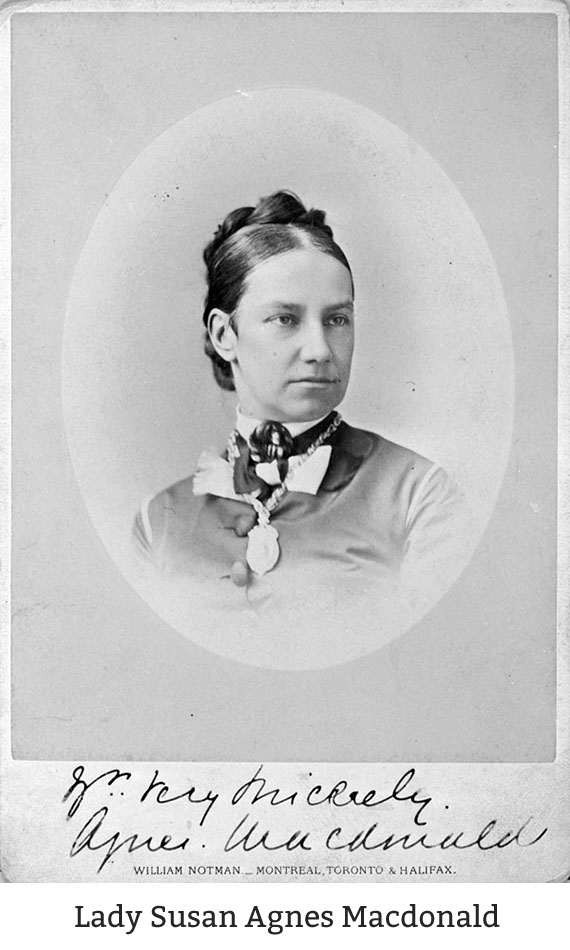
Researching a Mother of Confederation
Pick one of the four Mothers of Confederation:
- Anne Brown
- Mercy Anne Coles
- Luce Cuvillier
- Lady Agnes Macdonald
You will be researching the Mother of Confederation you selected. Your research will be guided by the two questions located in the following fillable and printable document entitled Researching a Mother of Confederation.
You can start your research using the Canadian encyclopedia websites or Canadian museum websites.
You can also complete this activity using a method of your choice.
Use the following interactive checklist to ensure you’ve answered all the questions.
Research Checklist
Complete Researching a Mother of Confederation in your notebook, in the following fillable and printable document, or in a method of your choice.
| Mother of Confederation Selected | |
|---|---|
| What was their relationship to a Father of Confederation? | |
| What contributions did the Mother of Confederation make to the conferences that led to Confederation? |
Press the ‘Activity’ button to access Researching a Mother of Confederation.
Press ‘Answers’ to check and confirm your research.
| Anne Brown: | Mercy Anne Coles: |
|
|
| Luce Cuvillier: | Lady Agnes Macdonald: |
|
|
Consolidation
What were the most important reasons for Confederation?
Use the personal rankings you assigned to the reasons for Confederation from the Action section. You will use your top two reasons for this activity to help answer the following questions. You may answer them using a method of your choice.

- How would this reason for Confederation impact the new country?
- What change did politicians hope this reason may make for the new country?
Contributors of Confederation
Examine the picture of the Fathers of Confederation again from the Action section and answer the following two questions:
- Should the Mothers of Confederation be equally recognized for their contributions as the Fathers of Confederation were? Why or why not?
- What other groups or individuals are missing from the discussion on the Confederation of Canada?
- If you had to redo the painting of Confederation, who else would you include? Why?

A painting by Robert Harris portrays the Fathers of Confederation. Originally commissioned to represent the representatives at the Charlottetown Conference of 1864, the painting was later expanded to feature all thirty-six Fathers of Confederation. The painting was installed in the original Parliament Buildings in 1884.
Source: Confederation, 1867. The Canadian Encyclopedia, 21 March 2017, Historica Canada. https://www.thecanadianencyclopedia.ca/en/article/confederation-1867
Source: “Professional Exchange.” Learning Centre, Virtual Museum of Canada, www.virtualmuseum.ca/edu/
Source: Waite, P.B. et al. «Fathers of Confederation». The Canadian Encyclopedia, 18 December 2019, Historica Canada. https://www.thecanadianencyclopedia.ca/en/article/fathers-of-confederation
Reflection
As you read the following descriptions, select the one that best describes your current understanding of the learning in this activity. Press the corresponding button once you have made your choice.
I feel...
Now, expand on your ideas by recording your thoughts using a voice recorder, speech-to-text, or writing tool.
When you review your notes on this learning activity later, reflect on whether you would select a different description based on your further review of the material in this learning activity.
Press ‘Discover More’ to extend your skills.
Discover More